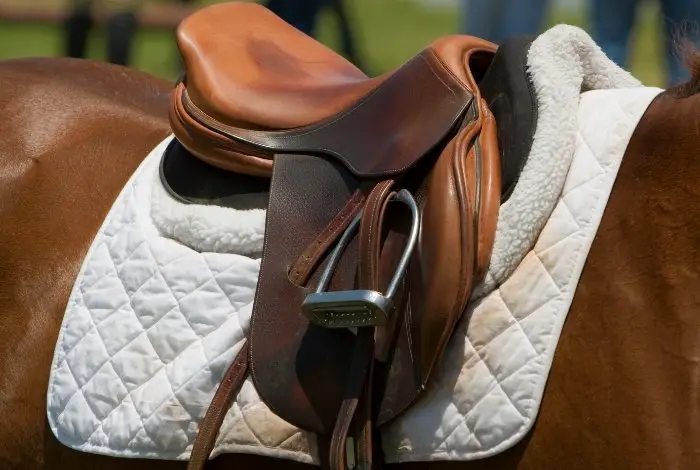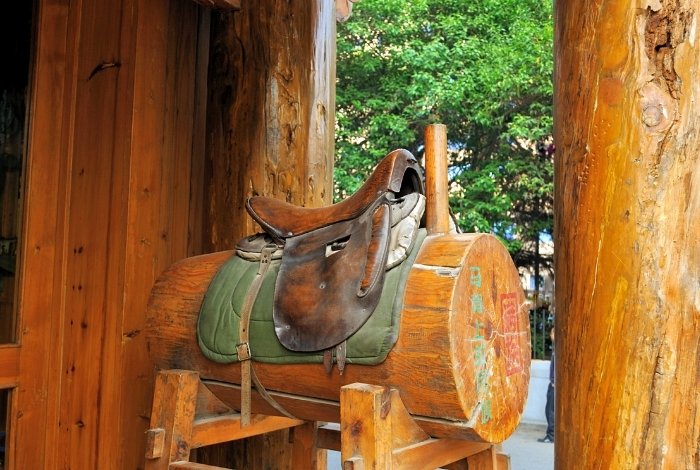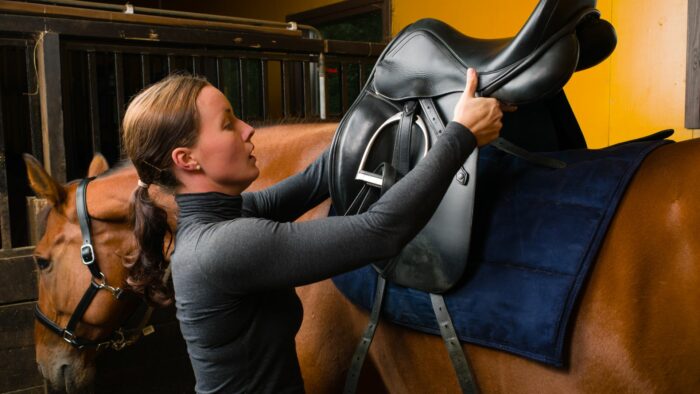Last Updated on March 24, 2023
Saddle fit is quite a complex topic, especially when it comes to sizing. Using an English saddle size chart can help you determine the right size saddle for you and your horse.
A saddle must not only be a comfortable fit for the rider but must be sized appropriately for the horse. Improperly fitted tack may result in pain, muscle atrophy, and possible behavioral issues. So what size English saddle do you need? We’ve covered sizing basics to help get you started:
Determining Saddle Style
English is a broad term- this covers saddles made specifically for jumping, dressage, saddle seat, and even the standard AP (all-purpose) saddle. Most competitors will have a specific style in mind to suit their discipline of choice. However, a beginner rider without a specific interest might not have as much direction.
Determining the saddle type will be the first step in sizing your future saddle. Although most English saddles are sized based on their gullet width (narrow, medium, wide, etc.), some have numerical sizing for tree designs and sizes.

What Size English Saddle Do I Need?
English saddle size chart
The standard way of saddle measurements, although helpful, does not consider body types. Traditionally, a person will sit in a chair at a 45-degree angle with flat feet. A measurement from the knee to the rear of the buttocks is taken. The conversion English saddle size chart below is used:
Your measurement of your saddle size
| <16.5” | 15” saddle |
| 16.5” to 18.5” | 16” saddle |
| 18.5” to 20” | 16.5” saddle |
| 20” to 21.5” | 17” saddle |
| 21.5” to 23” | 17.5” saddle |
| 23+” | 18” saddle |
However, this does not take body shape into account. Someone with an extremely short femur measurement may be pear-shaped and require a much bigger seat. We recommend this as a starting guideline.
Once in a saddle, a rider should have approximately 2-4 fingers width between the rear and the cantle of the saddle, as well as the front. If you are between sizes, it is best to go up. Again, these measurements are someone subjective due to riders’ personal fit preferences and comfort levels.
With a rider’s feet properly positioned in the stirrups, knees should rest directly on the knee rolls, and not over-extended. The saddle should not “pitch” the rider in either direction and allow a balanced seat position.
The measurement for a saddle seat saddle aka a cutback saddle or lane fox saddle differs from dressage and jumping saddles. For example, a rider who typically rides in a 17-inch dressage saddle will generally use a 21-inch saddle seat saddle.
Upper leg length cutback saddle size
| 16 1/2 inches | 19 inches |
| 18 1/2 inches | 20 inches |
| 20 inches | 20-21 inches |
| 21 1/2 inches | 21 inches |
| 23 inches | 21-22 inches |
| 23 inches or more | 23 inches |
Western comparison
English saddles, excluding cutback styles, typically measure 2 inches more than a western saddle. This means if you ride in a 15” western saddle, you are likely going to fit a 17” English saddle. However, this may not translate directly with extremely padded equitation western saddles, or for barrel racers in very snug seat sizes.
Find The The Best Saddle for Trail Riding
AceRugs All Natural Cowhide Western Leather Horse Saddle
Fitting Your Horse: English Saddle Size Chart
Once a rider has determined the saddle style and seat size, it is time for the most important step: fitting the horse. Be sure to check with your local saddle shop to see if they offer saddle fitting, or if they can refer you to a local fitter! We have found this video series by Jochen Schleese incredibly helpful and informative for anyone learning how to fit a saddle.
The nine primary elements of saddle fit are:
Balance
Saddle fitting should be performed without a pad, standing square on a flat surface. You will first properly place the saddle on your horse to look at overall balance and if there is any “tilt” or pitch in either direction. The seat surface should sit parallel to the horse’s spine and the ground.
Wither clearance
You will then check for adequate clearance between the saddle’s pommel and your horse’s wither. Two to three finger-widths is the general guideline- keep in mind that motion and pad will affect this.
Channel width
The channel, or the mid-tree space between panels, should provide enough clearance around the spine and ligaments to avoid pinching, but should not be set low on the ribs. Just because a saddle has an adjustable gullet width does not mean the channel width is changed.
Billet alignment
Check for straight and perpendicular billet alignment. This will also determine the girth path, which should be approximately 5 inches behind the elbow to avoid interference. If billets sit crooked, this can indicate the saddle is pitched on the horse.
Total length
The thoracic vertebrae are the weight-bearing surface for a horse. A saddle shouldn’t extend any weight-bearing surface onto the lumbar. Total saddle length should not extend beyond the floating ribs, easily identified by the change in hair pattern just before the plank.
Shoulder clearance
Saddles should allow freedom of movement and no interference of the shoulder. Some breeds like Morgans or Saddlebreds will need additional shoulder clearance for high action.
Full panel contact
The panels of your saddle should have full contact with the horse, particularly when the abdomen is engaged. Some degree of bridging will disappear during engagement/collection.
Straightness
Always check the integrity of the tree and ensure it is straight and fits your horse straight.
Treewidth
Brands differ in how trees are sized, and unfortunately, there is no industry standard. Breed and height can help determine where to start, but some stockier breeds may even need hoop trees rather than a “wide” or “extra-wide” tree.
English Saddle Seat Size
Knowing the sizes that English saddles come in will help you determine the right size of the saddle for you. The size of the saddle will vary by the type of saddle you are using.
Typically, jumping saddles and all-purpose saddles range in size from 15 inches to 18 inches, with half sizes in between. Dressage saddles typically come in sizes from 16 1/2 to 18 inches.
The sizing for cutback saddles is different than jumping, all-purpose, and dressage saddles. Cutback saddles, which are made for saddle seat riding, generally come in sizes from 19 to 23 inches.
Average-size women’s saddle
The average size of a women’s all-purpose or close-contact saddle is generally 16 1/2 or 17 inches. For dressage, the average size is generally a 17-inch for a woman. In saddle seats, the average size of a cutback saddle for a woman is generally 21 or 22 inches.
How to Measure a Horse for an English Saddle
Just as your saddle must fit you comfortably, it is vital that your saddle also fits your horse comfortably. An ill-fitting saddle can potentially lead to lameness or behavioral problems.
To ensure a saddle properly fits your horse, you want to first make sure the saddle is correctly placed on the horse’s back. The saddle should sit behind your horse’s shoulder blades to allow his freedom of movement and should rest naturally in place as dictated by his confirmation. Be sure not to place the saddle too far on your horse’s withers.
Next, test the wither clearance of the saddle. You should be able to fit about three or even four fingers between the pommel and withers. If you have too much space, the tree may be too narrow and if you don’t have enough space, the tree may be too wide.
The saddle should also sit level on the horse’s back. The deepest part of the seat should not tilt forward or lean backward. This is important to make sure your saddle will have an even weight distribution.
Be sure to also check the length of your saddle. Your saddle should never go beyond the 18th vertebrae of your horse. Make sure to also check for gullet clearance and be sure that the saddle is not pinching your horse in any spot.
It is best to check the fit of the saddle without using a saddle pad or girth. After testing for all the factors above, you can properly tack up your horse and take the saddle for a trial ride.
While riding, make sure you feel comfortable in the saddle. Also, be sure to make sure your horse is moving comfortably in the saddle too. If your horse is reluctant to move or is taking short strides, this may be a sign that the saddle does not fit comfortably.
Child English Saddle Size Chart
Just as for adults, it is important to make sure a saddle properly fits a child too. A saddle that is too large for a kid can cause them to ride in an incorrect position. The rules for measuring a saddle for a child are the same as for an adult.
Typically, children’s all-purpose and close-contact saddles will range in size from 14 inches to 15 3/4 inches.
Your measurement of your saddle size
| 15.5 inches or less | 14 inches |
| 16 to 16.5 inches | 15 inches |
| 16.5-17 inches | 15 3/4 inches |

Closing Thoughts: English Saddle Size Chart
Measuring for an English saddle is a two-part process, important to both horse and rider. Using this English saddle size chart guide can help find the right fitting saddle. For more information or a saddle fitter near you or contact your local tack shop.
Frequently Asked Question
Equestrian, Marine Corps vet, and Morgan horse enthusiast.


